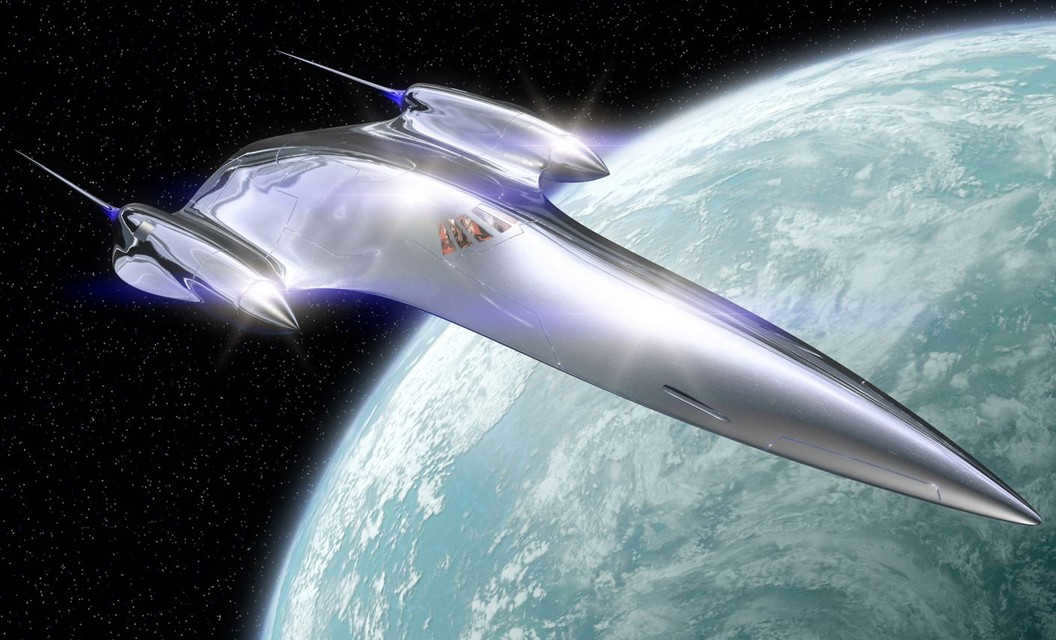
The concept of relativity is truly captivating with its contradictory nature. We are all familiar with the famous examples involving twins and the possibility of fitting a long airplane into a small box. Nowadays, even high school graduates are well-versed in these classic enigmas, and even physics students believe that they have unraveled all the mysteries of the special theory of relativity.
All seems well, except for one disheartening fact – the impossibility of surpassing the speed of light. Is there no way to travel faster?! – I used to wonder as a child. Well, perhaps there is. So I invite you to an exploration, a sort of black or white magic in the name of Albert Einstein, with the revelation awaiting at the end. And for those who crave more, I have also prepared a challenge.
UPDATE: After a full day, I am ready to present the solution. You will find a plethora of new content, including text, formulas, and graphs, at the conclusion of this post.
Embarking on a Journey to Alpha Centauri
I extend an invitation to join us aboard our interstellar vessel as we embark on a voyage to Alpha Centauri. Our destination lies a mere four light-years away. Attention, prepare for liftoff! To ensure the comfort of our passengers, our captain has adjusted the propulsion system to replicate the familiar magnitude of acceleration and gravitational force experienced on Earth.
Now that we are already moving at a decently accelerated pace, let’s say about half the speed of light, we can consider a seemingly simple question: what speed will we be approaching Alpha Centauri in our own frame of reference (the ship’s frame of reference)? It may seem straightforward, as if we are flying at a speed in a stationary frame of reference relative to both the Earth and Alpha Centauri, then from our perspective, we would be approaching the target at a speed of .
However, anyone who has already sensed the catch is absolutely correct. The answer is incorrect! Here, we need to make a clarification. When I refer to the speed of approaching Alpha Centauri, I am referring to the change in the remaining distance to it, divided by the time interval over which such a change occurred. And, of course, all of this is measured in our frame of reference associated with the spacecraft.
In our minds, it is crucial to keep in mind the phenomenon of Lorentzian length contraction. As we embark on a journey to reach half the speed of light, it becomes evident that the dimensional scale along the axis of our motion diminishes. Allow me to refresh your memory with the following formula:

And now, if we measure the distance from Earth to Alpha Centauri at half the speed of light, we will find that instead of 4 light-years, we only receive 3.46 light-years.
It appears that by accelerating, we have already reduced the remaining distance of the journey by approximately 0.54 light-years. And if we not only move at high speed but also accelerate, the scale factor will have a derivative of time, which essentially represents the speed of approach and addition to it.
Therefore, in addition to our usual, or classical, velocity, another term is introduced – the dynamic reduction of the remaining path length, which occurs only with non-zero acceleration. So let’s grab a pencil and do the calculations.

Here we can observe that the initial derivative is the rate of change of speed, specifically the negative rate of change of speed as we approach Alpha Centauri. However, the second term is the crucial element that I suspect not everyone has considered.
In order to determine the time derivative of velocity in the second term, one must exercise caution since we are in a moving frame of reference. The simplest method to calculate this is by using the formula for the addition of relativistic velocities. Let’s assume that at a certain moment in time, we are moving with a velocity of , and after a certain time interval, we have increased our velocity by . According to the formula of the theory of relativity, the resulting velocity will be

Now, let’s combine equations (2) and (3), and calculate the derivative of equation (3) at , as we are considering small increments.

Now, let’s examine the ultimate equation

It’s incredible! If the first factor – velocity – is bound by the speed of light, the second factor has no bounds! Increase it and… the second factor can easily surpass the speed of light.
– What? What? – Some people may doubt it.
– Yes, yes, that’s precisely what it is, I’ll respond. – It can surpass the speed of light, surpass two times the speed of light, surpass 10 times the speed of light. To rephrase Archimedes, “Give me the appropriate one and I’ll give you any desired speed.”

It’s 0.33 times the speed of light.
Let’s keep being astonished
Let’s examine formula (5) more meticulously. There’s no need to board a spaceship that travels at relativistic speeds. Both velocity and acceleration can be relatively low. It’s all about the enchantment. Ponder upon it!
As I hop into my car and press down on the accelerator, I am filled with a sense of speed and power. Little do I know, somewhere out there in the vast expanse of space, there are objects hurtling towards me at a velocity faster than light. Now, I must admit that I haven’t taken into consideration the Earth’s orbit around the Sun or the Sun’s movement around the center of the Galaxy. Once these factors are taken into account, these superluminal objects will appear much closer to us, not on a cosmological scale, but perhaps on the outskirts of our very own Galaxy.
It’s fascinating to realize that even in our everyday lives, we unknowingly participate in faster-than-light motion. Something as simple as standing up from a chair can create a minimal acceleration that propels us into this realm of FTL travel.
We ponder further
Take a close look at equation (5). Instead of focusing on the speed of approach to Alpha Centauri, let’s examine the opposite – the speed of departure from Earth. If this speed is sufficiently high, such as halfway to the destination, we may discover that both Earth and Alpha Centauri are actually approaching us. Once the initial surprise subsides, we can speculate that the culprit behind this phenomenon is length contraction, which not only operates forward but also in reverse. As we venture further away from the launch point, the space behind the spacecraft shrinks at an even faster rate.
There is another unexpected phenomenon that can be easily comprehended. In fact, if we alter the direction of acceleration, the second term in equation (5) will instantly switch its sign. This means that the initial velocity could easily become zero, or even negative. However, our overall velocity will still be directed towards Alpha Centauri.
I hope I’ve sufficiently bewildered you. We were instructed that the speed of light is the ultimate velocity! You cannot approach anything faster than the speed of light! However, it is important to take note of the prefix to any relativistic principle. It is present in every textbook, yet it appears to only clutter the formulation, despite being the key component. This refrain emphasizes that the postulates of the special theory of relativity function “in an inertial frame of reference”.
In a non-inertial frame of reference, Einstein does not provide us with any guarantees. That’s just the way it is!
Formula (5) includes the measurement of distance. When the distance is zero, which means we are trying to calculate the velocity locally relative to nearby objects, only the first term remains, which is always less than the speed of light. This poses no problem. However, at larger distances, when we are not considering local measurements, superluminal velocities can be obtained.
It is important to note that the concept of relative velocity between distant objects is not well-defined in general. In our flat space-time, an accelerated frame of reference appears curved. This is similar to the famous Einstein elevator, which is equivalent to a gravitational field. When comparing two vector quantities in curved space, it is only valid to do so when they are at the same point (in the same tangent space of the corresponding vector bundle).
Speaking of our paradox of superluminal velocity, there is another way to reason about it, I would say comprehensively. When we consider relativistic travel to Alpha Centauri, it will actually take much less than 4 years according to the astronaut’s own perception of time. So, if we divide the initial distance by the time experienced by the astronaut, we will find that the effective speed is greater than the speed of light. This is essentially similar to the twin paradox. For those who find it comfortable, this is how faster-than-light travel can be understood.
That’s the clever part. Your Captain Hindsight.
And lastly, I have a task for you all to complete or an outline for discussion in the comments..
A unique task.
The inhabitants of planet Earth and the extraterrestrial beings from Alpha Centauri have come to an agreement to exchange diplomatic missions. An interstellar spacecraft was successfully launched from Earth, hurtling through the vastness of space at an incredible velocity. Simultaneously, a remarkable alien flying saucer, belonging to the Alphacentaurs, embarked on its own journey with equal swiftness, aiming to rendezvous with the Earth-bound vessel.

What is the distance between the Earthlings’ ship and Alpha Centauri in the Earth’s reference frame at the time of launch? Please leave your answer in the comments.
UPD: Solution
So here is the solution to the problem. Let’s analyze it qualitatively.
Assuming that the clocks on Alpha, Earth, the rocket, and the saucer are all synchronized (which was done in advance), and the launch on all four clocks occurred at 12:00.
Let’s visualize space-time graphically in resting coordinates. Earth is at zero, Alpha is located at a distance along the axis. The worldline of Alpha Centauri clearly moves vertically upwards. The saucer’s worldline slopes to the left, indicating its movement away from Earth.
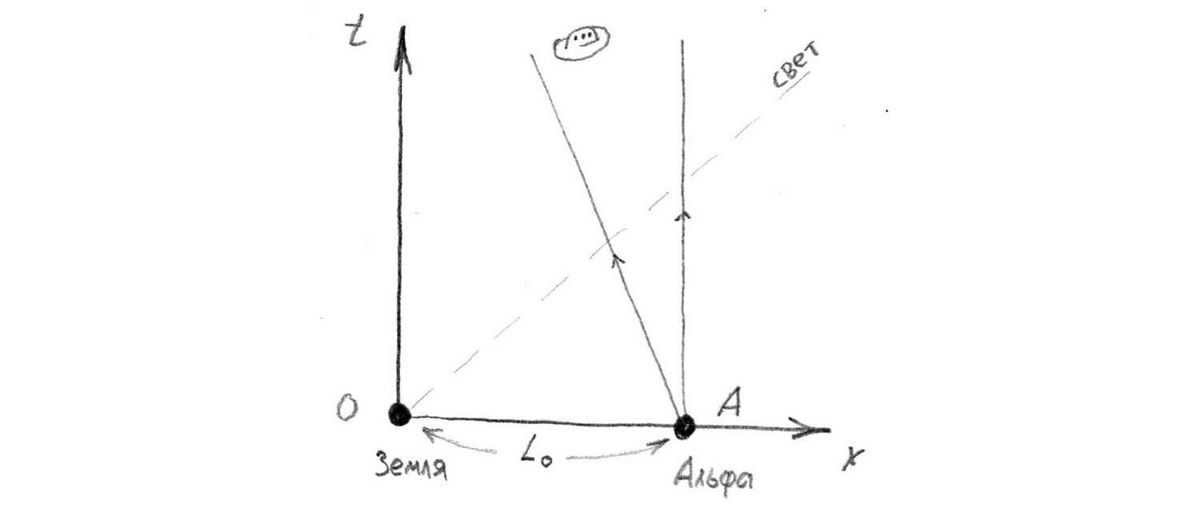
On this chart, we can depict the coordinate axes of the rocket’s reference frame when it is launched from Earth. This change in the coordinate system is known as a boost. In this scenario, the axes are evenly inclined around the diagonal line that represents the beam of light.
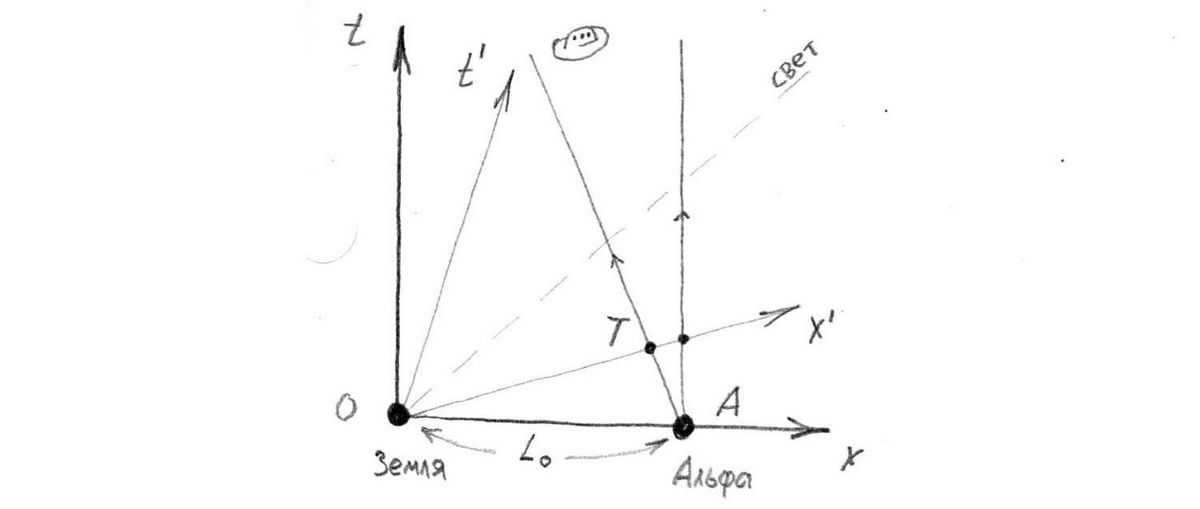
I believe, by this point, everything should be clear to you. You see, the axis intersects the world lines of Alpha and the flying saucer at different points. What occurred?
An incredible occurrence. Prior to liftoff, from the rocket’s perspective, both the saucer and Alpha were at the same position, but after accelerating, it turns out that in a moving spacecraft, the rocket’s launch and the saucer’s launch were not simultaneous. The saucer unexpectedly launched earlier and managed to get slightly closer to us. So now, at 12:00:01 on the rocket’s clock, the saucer is closer to us than to Alpha.
Furthermore, if the rocket accelerates further, it will “leap” to the next spacecraft, where the flying saucer is even closer. This unique approach of the saucer is solely due to acceleration and dynamic compression of the longitudinal scale (as discussed in my previous post), rather than the rocket’s advancement in space, as the rocket has not had sufficient time to travel extensively. This approximation of the saucer represents the second term in formula (5).
In addition, we must also consider the typical Lorentzian reduction of distance. Let me inform you that at the velocities of both the rocket and the saucer, the distances are as follows:
- between the rocket and Alpha: 3.46 sv. year (the customary Lorentzian contraction).
- between the rocket and the saucer: 2.76 sv. year.
Next, let’s establish some basic notations. In the field of physics, we commonly treat the speed of light as equal to one. This simplifies calculations and is a standard practice among physicists. Additionally, we often consider Planck’s constant and the gravitational constant to also be equal to one. While this doesn’t change the fundamental concepts, it greatly simplifies the notation used in equations and formulas.
Now, let’s discuss the “relativistic root” which we will refer to as the gamma factor for the sake of brevity. This factor relates to the velocity of the Earth’s rocket:

Next, we will proceed to constructing the vector in its components:

The time component is represented by the upper part, while the spatial coordinate is represented by the lower part. In the stationary system, the ships start at the same time, so the upper component of the vector is zero.
Now, we need to determine the coordinates of the point in the moving coordinate system, denoted as . To do this, we utilize a transformation to the moving frame of reference, known as a boost. This boost is a simple multiplication of any vector by the boost matrix.

From the given information, it is evident that the time element of this vector has a negative value. This indicates that, from the perspective of the rocket in motion, the point is located below the axis, meaning it is in the past (as depicted in the above diagram).
Now, let’s determine the vector in the stationary system. The temporal element represents an unspecified duration of time, while the spatial element corresponds to the distance covered by the saucer during this time period, as it moves with a velocity of .

Now, the vector is in the system.

Let us discover the standard vector addition.

What was my reason for associating this particular value on the right side with a vector? According to the definition, the point lies on the axis, meaning that the time component must be zero, while the spatial component represents the distance between the rocket and the saucer. As a result, we end up with a system of two straightforward equations – we set the time components equal to each other separately, and likewise for the spatial components.

By solving the initial equation, we can determine the value of the unknown parameter, which can then be substituted into the second equation to obtain the result. I will skip the straightforward calculations and provide the final answer:
Groundbreaking scientific breakthroughs frequently occur unexpectedly, much like a sudden realization. Fiction and fantasy movies often provide inspiration for “discovering” the perfect idea. Writers, like prophets, introduce revolutionary concepts that may later be realized years down the line.

Moon Travel
A visionary who foresaw many technological advancements was the renowned author Jules Verne. He accurately predicted the development of electric cars, submarines, helicopters, and more. Initially, Verne’s ideas were seen as mere imaginative tales, but as time went on, the scientific community began to take his concepts seriously. For instance, Verne imagined the use of gas-discharge lamps on the Nautilus, even though it was the mid-19th century when such devices were not yet practical and only became widely used seventy years later.
The renowned science fiction author made predictions about space travel, disregarding the method of launching rockets with a cannon shot. Nonetheless, the overall stages of launch and flight preparation were remarkably accurate. The writer meticulously calculated the rocket’s dimensions, interior layout, life support system, and even accurately anticipated the launch site in Florida, all of this a century prior to the Apollo program.

Space Odyssey
In this day and age, it’s becoming increasingly challenging to amaze people. It would seem that science fiction writers have already thought of everything, and it’s just a matter of time before these ideas become a reality. However, there are scientific constraints that hinder humanity’s groundbreaking leap. One such “obstacle” is Albert Einstein’s theory of relativity, which states that no object can surpass the speed of light.

There is a contentious debate within the scientific community regarding the foundational principles of the theory of relativity. While some individuals embrace its concepts, others are reluctant to accept them. If we can agree that the speed of light cannot be exceeded, how can we possibly navigate the vast expanse of the cosmos in the future? Several scientists have pondered this question extensively and have uncovered certain theoretical “loopholes”.
Interestingly enough, the notion of “outsmarting” Einstein’s theory originated from the realm of science fiction, specifically the immensely popular TV series “Star Trek”. The show featured a spaceship piloted by humans that possessed a unique engine capable of contracting space in front of it while simultaneously expanding it behind, enabling instantaneous travel across immense distances.
Many scientists, who also watched the series, found the concept of compressing space to be an entertaining plot device. However, one particular scientist named Miguel Alcubierre saw true potential in this idea.
High-speed transportation
In the 1990s, a physicist from Mexico named Miguel Alcubierre developed a theory that proposed a way to travel faster than the speed of light in space without contradicting Einstein’s principles. He conceived the concept of the “Alcubierre bubble,” which would allow a spaceship and its crew to travel through space at a rapid pace while maintaining a realistic experience of time for the human body.
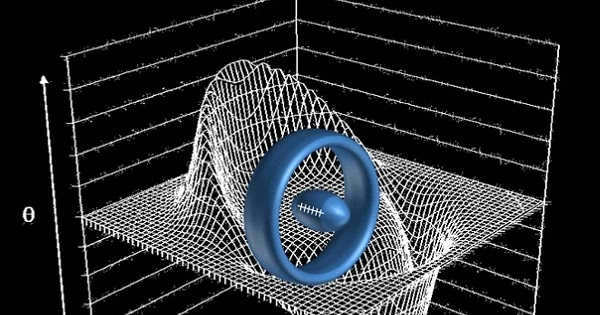
A group of scientists, including Harold White from NASA, became intrigued by the concepts proposed by the Mexican. In 2012, they developed an innovative device capable of detecting changes in the fabric of space-time caused by electromagnetic fields. Encouraged by successful tests, the team has now moved on to the next phase of the project, codenamed “Speed.” Their current focus is on constructing a prototype engine that can manipulate space itself.
Based on calculations, this groundbreaking engine could potentially transport a spacecraft to Alpha Centauri in a mere two weeks. Interestingly, the design of the ship is expected to resemble the iconic starship from the television series “Star Trek.”
Currently, White and his team are in the process of developing a compact model that has the capability to slightly distort the space surrounding it. These experiments involve the use of high-frequency lasers and capacitors charged with thousands of volts. The dedicated team at L. Space Center is confident in the success of their endeavors.
Perhaps in the future, through the collaborative efforts of writers, directors, and scientists, space travel will become more accessible than it appears to be at present?
That’s an extremely fascinating fact:
For centuries, humanity has harbored a deep desire to explore the closest planets, yet we have not yet managed to step foot on our “Red neighbor” – Mars. However, astronomers have recently discovered a unique class of planets known as “exoplanets” – planetary bodies that possess the potential to sustain life. While the prospect of interstellar travel is still in its infancy, it is worth contemplating how long it would take to reach the nearest exoplanet.

“Second Earth.”
Currently, astronomers have detected a number of potentially habitable planets, with the closest one being planet 452b. This planet orbits a star labeled 452, and is located approximately 1400 light years away from us. Its temperature is very similar to that of our Sun. Similar to our own Sun, Kepler 452 (named after the telescope “Kepler” that discovered it) is also classified as a yellow dwarf. This means that the star’s “habitable zone” is comparable to ours.
Planet 452b closely resembles our Earth, as it follows a similar orbit around its star. The length of a year on this planet is almost the same as Earth’s, and there is an adequate amount of light and heat for life to flourish.
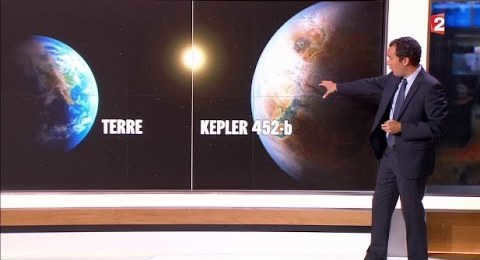
Kepler 452b is significantly larger and heavier than Earth, with its mass exceeding that of our planet by almost 60 percent. Moreover, the gravity on 452b is twice as strong as Earth’s gravity. As a result, it would be challenging for potential Earth colonists to immediately adapt to the new planet due to our bodies not being accustomed to such high gravity. Nevertheless, future technological advancements may offer solutions to this issue if humans manage to reach 452b.
What is the estimated duration of the flight?
If we are considering sending a spacecraft to the nearest exoplanet, the current fastest spacecraft on Earth, New Horizons, which can travel at a speed of 50,000 kilometers per hour, would take approximately 26 million years to reach its destination! This is clearly an impractical amount of time, so we would need to make significant advancements in superluminal speeds before such a mission could be feasible.
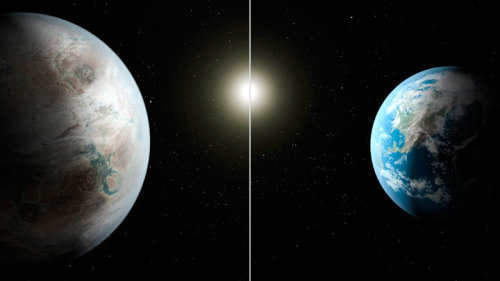
However, should humanity manage to develop spaceships capable of attaining the speed of light, it would take a mere 1400 years to travel to 452b. In order for our ancestors to have reached this planet by 2015, they would have had to depart in 615 BC.
Currently, humanity is constrained when it comes to long-distance space travel. As a starting point, it is necessary for humans to visit Mars, an event that will undoubtedly be monumental in the annals of our species. Only after that can we begin to ponder the prospect of embarking on voyages to other stars.
How much time does it require to travel to alpha centauri? What is the distance to the Alpha Centauri stellar system? Is it feasible to travel to Alpha Centauri? It significantly increases the distance covered.
What is the distance to the Alpha Centauri stellar system? Is it feasible to travel to Alpha Centauri?
Alpha Centauri serves as the destination for spaceship missions in numerous works belonging to the genre of science fiction. This nearest star to us is associated with the celestial figure representing the mythical centaur Chiron from Greek mythology, who served as the mentor of Hercules and Achilles.

Contemporary scientists, as well as authors, continuously contemplate this stellar system, as it is not merely the primary contender for an extensive interstellar journey but also conceivably holds a habitable celestial body.
Composition
The arrangement of the Alpha Centauri stellar system consists of three celestial bodies: two stars known as A and B, as well as Proxima Centauri. These stars are distinguished by their close proximity of two components and a more distant third. Proxima Centauri is the latter of the three. The total distance to the Alpha Centauri system, including all its elements, is approximately 4.3 light-years. Currently, there are no stars that are closer to Earth than Alpha Centauri. However, Proxima Centauri is the most easily reachable, as it is only 4.22 light-years away from us.
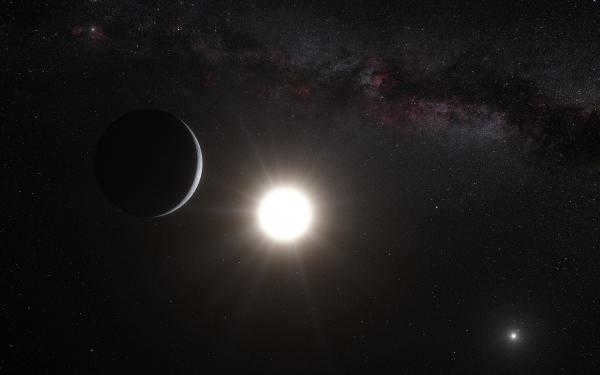
The Solar Family
Alpha Centauri A and B are distinct from their companion, not just in terms of their distance from Earth. Unlike Proxima, they bear a resemblance to the Sun in many ways. Alpha Centauri A, also known as Rigel Centaurus (which translates to “Centaurus’ foot”), is the brighter star of the pair. It is a yellow dwarf, just like the Sun. It is easily visible from Earth due to its zero stellar magnitude, making it the fourth brightest object in the night sky. The size of Alpha Centauri A is almost identical to that of the Sun.
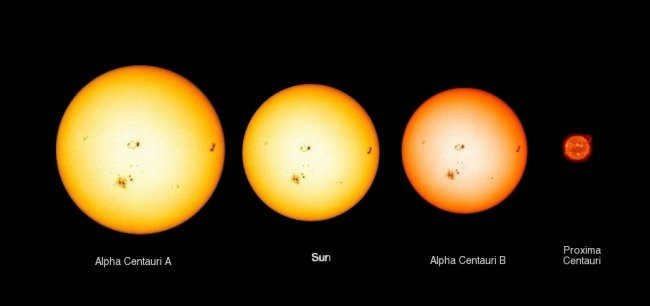
The star Alpha Centauri B has a mass that is inferior to our Sun (approximately 0.9 times the value of the Sun’s mass). It is classified as a first magnitude object and its luminosity is roughly half that of our Galaxy’s main star. The distance between these two neighboring companions is 23 astronomical units, which is 23 times greater than the distance between the Earth and the Sun. Toliman A and Toliman B both orbit around the same center of mass, completing one revolution every 80 years.
The recent finding
As previously stated, scientists are optimistic about the possibility of discovering life near the Alpha Centauri star. It is believed that the planets in this area may bear resemblance to our own Earth, just as the components of the system resemble our sun. Until recently, no such celestial bodies had been found in close proximity to the star. Due to the distance, direct observation of these planets is not feasible. However, advancements in technology have made it possible to gather evidence of the existence of a planet similar to Earth.
Scientists have successfully detected minute oscillations of Toliman B by utilizing the ray velocity method, which are caused by the gravitational forces exerted by the planet orbiting it. This provides compelling evidence for the presence of at least one celestial body within the system. The planet’s influence is evident through its displacement of 51 centimeters per second in a forwards and backwards motion. On Earth, such movement would be easily observable even in larger objects. However, detecting such oscillations at a distance of 4.3 light years seems implausible. Nonetheless, it has been documented.
Earth’s sibling

The planet discovered revolves around Alpha Centauri B in a period of 3.2 days. It is situated in very close proximity to the star: the size of its orbit is one-tenth that of Mercury’s. The mass of this celestial body is similar to that of Earth and is approximately 1.1 times the mass of our Blue Planet. However, this is where the similarities end: scientists believe that the planet’s close proximity to the star makes the emergence of life impossible, as the intense heat from the star’s energy reaching its surface is too high.
The closest
Alpha Centauri C or Proxima Centauri is the third component of the star system that is known for making the entire constellation famous. The cosmic body is appropriately named “nearest” as it stands 13,000 light-years away from its companions. Proxima Centauri is an eleventh magnitude object, specifically a red dwarf, and is relatively small, being about 7 times smaller than the Sun. Despite its significance, it is not visible to the naked eye due to its faintness. Proxima Centauri is known for its “restless” state, with its luminosity magnitude capable of changing by a factor of two within minutes. This unusual behavior is believed to be caused by internal processes occurring within the dwarf star.
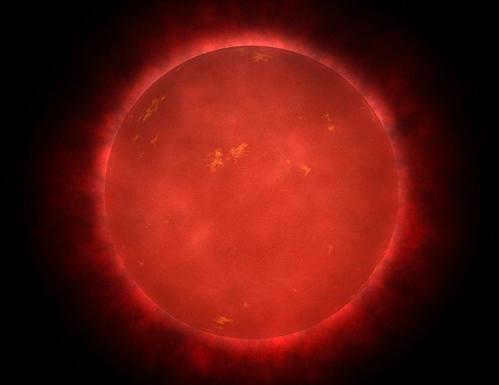
The Dual Position
For a long time, Proxima has been regarded as the third component of the Alpha Centauri system, orbiting around the A and B pair in approximately 500 years. However, there is a growing belief that the red dwarf is not actually associated with them, and the interaction between the three celestial bodies is only a temporary phenomenon.
Projects
However, the primary focus for future space exploration is Proxima, which is anticipated to be the initial destination once feasible. Given the current state of space technology, the voyage to Alpha Centauri could span over 1000 years. This duration is undeniably inconceivable, prompting scientists to actively explore possibilities for its reduction.
Harold White and his team of NASA researchers are currently working on a project called “Speed” that aims to create a revolutionary new engine. The unique feature of this engine will be its ability to surpass the speed of light, making it possible to travel from Earth to the nearest star in just two weeks. This incredible engineering feat will require the collaborative efforts of both theoretical and experimental physicists. However, at present, achieving interstellar travel at faster-than-light speeds remains a distant possibility. Mark Millis, a former NASA employee, estimates that it will take at least two hundred years for such technology to become a reality, assuming the current rate of progress. The only way to significantly shorten this timeframe is if a groundbreaking discovery is made that completely revolutionizes our understanding of space travel.
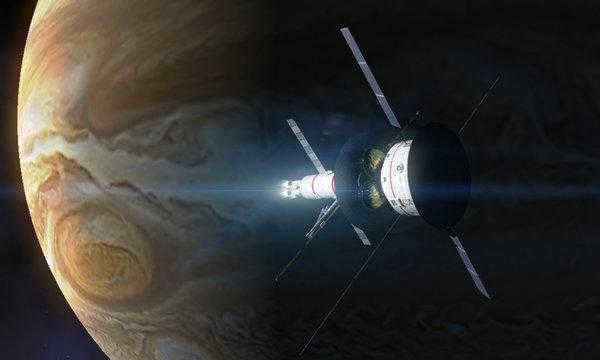
At present, reaching Proxima Centauri and its companions is an ambitious objective that cannot be achieved in the foreseeable future. However, advancements in technology are constantly being made, and the availability of new data on the star system’s properties serves as undeniable proof of this. Even today, scientists are capable of accomplishing tasks that were unimaginable 40-50 years ago.
Alpha Centauri: An Exploration of its Distance from Earth and Time Required for Flight
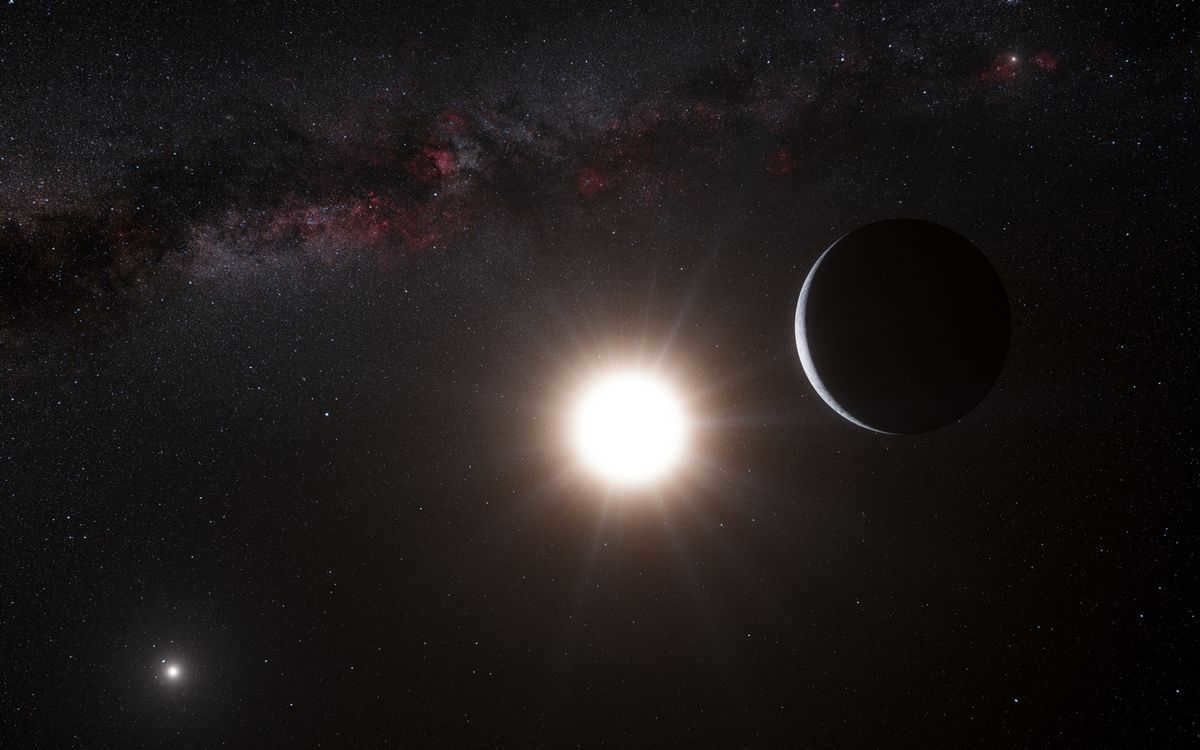
For those who are new to the field of astronomy and have a fascination with stars, it would be beneficial to gain knowledge about the characteristics and distance of Alpha Centauri.
Alpha Centauri: an overview
Alpha Centauri is not just a single star, but a celestial system consisting of three objects, and it is the closest one to the Sun. It can primarily be observed by astronomers in the Southern Hemisphere by visually tracing a line across the horizontal part of the Southern Cross constellation. It is among the three brightest objects in the sky that can be easily seen with the naked eye. This primarily refers to its two components, Alpha Centauri A and B, which are closely merged together. These two components share such similar characteristics that it is impossible to differentiate them without the use of specialized equipment. However, with a simple telescope, one can observe the relatively small distance of 23 astronomical units between them (1 astronomical unit represents the distance from the Earth to the Sun, which is approximately 149.6 million kilometers). The third component, known as the red dwarf Alpha Centauri C (also referred to as Proxima Centauri), is practically invisible and is separated from the A and B stars by 2.2 degrees. Let us now examine each element of this cosmic system individually.
Centaurus A is known by other names, including:
- Rigel Centaurus – derived from Arabic, meaning “the foot of Centaurus”. This name was given because of the association of Alpha Centauri with the constellation Centaurus (Centaurus), allowing the Greeks to identify the location of the object;
- Bungula – likely taken from Latin, meaning “hoof”;
- Toliman – the rarest variation, mainly used by astrologers. If we consider the Arabic origins of the name, it can be translated as “Ostriches”.
Compared to the Sun, Centaurus A is 0.08 times heavier and has a radius 1.2 times larger. It shines much brighter, emitting a white-yellow glow, and its temperature can reach 5753 K.
It is thought that billions of years ago, the Alpha Centauri system managed to “draw in” a third component from a neighboring galaxy – Proxima Centauri. The name of the star means “closest”, given its proximity to the Sun. Powerful flares emitted by the red dwarf have been observed on several occasions. In terms of its characteristics, it is dimmer and smaller than the Sun, with a mass of 0.123 times that of the Sun and a radius of 0.14 times that of the Sun. However, it is able to boast ten times the power as a source of X-ray radiation. The star’s temperature only reaches 2883 K, which is relatively low and may not seem sufficient to heat nearby celestial objects. Consequently, it would appear unlikely for planets to form in close proximity. Nevertheless, in 2016, the discovery of the planet Alpha Centauri C b, or Proxima Centauri b, orbiting around it, challenged this notion.
Alpha Centauri: planets and extraterrestrial life in space
Proxima Centauri b is the nearest known exoplanet to Earth, situated approximately 40 trillion kilometers away. This exoplanet was discovered using Doppler spectroscopy, also known as radial velocities. Proxima Centauri b has an orbital distance of 7.3 million kilometers from its star, resulting in an orbital period of roughly 11.2 Earth days. Despite its proximity to its star, the planet receives enough heat to maintain liquid water, preventing it from freezing into solid ice. The equilibrium temperature of Proxima Centauri b is 234 K. Unfortunately, there is currently limited data available to determine the potential for extraterrestrial life on this exoplanet.
However, the recent discovery of a planet in the Alpha Centauri system is not the first. In 2012, astronomers announced the existence of Alpha Centauri Bb, which was believed to be the closest planet to our solar system at the time. However, this assumption was later proven to be incorrect due to errors in data processing.
In 2019, a new project was launched to search for planets in the AB double star system.
How long will it take to fly from Earth to Alpha Centauri?
When it comes to measuring distances on a cosmic scale, we use light years, which represent the distance that light can travel in a vacuum within a certain amount of time. For instance, one light year equals 9,640 billion kilometers traveled by light in 365 days.
Alpha Centauri, located 4.37 light years away from the Sun, is currently the primary target for interstellar missions. However, it’s difficult to determine the exact duration of the journey in Earth time, as it depends on the speed of the spacecraft. Let’s explore a few examples of modern technologies that could potentially be used for such expeditions.
When it comes to the economics of a space mission to Alpha Centauri, one option worth considering is an ion propulsion engine. The European Space Agency’s SMART-1 mission took 13 months to reach the Moon, while Deep Space 1 took 20 months to reach Comet Borrelli. The ion engine has achieved a maximum speed of 56 thousand km/h so far. However, if we were to use this method, it would take over 80 thousand years to deliver an object to the Alpha Centauri star system.
A more efficient approach is to utilize gravitational maneuvering. Currently, the fastest unmanned spacecraft is “Helios 2,” which reached a speed of 253 thousand km/h. However, since this is only 0.02% of the speed of light, simple calculations indicate that it would still take approximately 18 thousand years to reach the Alpha Centauri star system.
In 2016, the Breakthrough Starshot project was proposed by billionaire Yuri Milner and physicist Stephen Hawking with the aim of reaching the Centauri stars. The project involves the creation of StarChip space mini-ships, which will be the size of a thumb drive and will be equipped with built-in cameras, sensors, power supplies, and other necessary equipment. These mini-ships will be propelled using a large light sail that is several meters wide and only a couple hundred atoms thick. On Earth, there will be laser installations with a combined power of 100 GW. These installations will help accelerate the speed of the mini-ships to 216 million km/h by focusing light beams onto the aforementioned sails.
There will be a simultaneous launch of 1000 unique designs, increasing the likelihood that at least one of them will successfully reach its final destination. The specific timeline for the project has not been disclosed, but you can attempt to calculate it yourself. Constructing a StarChip could take a couple of decades, followed by an equal amount of time for the actual flight, and a few additional years for data transmission. Overall, the results of the estimation are quite promising: it is possible that humanity will witness the first images of Alpha Centauri within the next fifty years.
Alpha Centauri, the closest solar system to Earth, is located 4 light years away.
How will humanity be able to overcome this immense distance?
Given that the ship is unable to reach the speed of light, currently available technologies do not have the capability to accelerate the ship to even sublight speeds. Therefore, it would take an estimated 15,000 to 40,000 years to travel to the nearest star using modern chemical jet propulsion.
However, are there any alternative methods to significantly shorten the journey to the Alpha Centauri system?
And that’s where the ion engine comes into play! The ion engine is a type of jet engine that relies on ionized gas being accelerated to high speeds in an electric field to produce jet propulsion. It is a well-established technology that has been successfully utilized by humanity. Currently, ion engines are being employed in Elon Musk’s Starlink project. Furthermore, the ion jet engine holds the record for speed, with the Dawn spacecraft reaching a velocity of 39,900 km/h in 2016. This is significantly faster than a chemical engine. While the journey would take approximately 1000 years, which is a considerable amount of time, it is still a notable achievement. Admittedly, the ion jet engine does have some drawbacks, such as extremely low thrust. However, it is likely that future advancements in technology will lead to increased engine power.
Guide to Utilizing a Light Sail
In agreement with Milner and Hawking’s initial proposal, a small, compact light sail measuring several meters in size will be affixed to the miniature probe. This sail will be maneuvered by a phased array of lasers. The energy generated by these lasers is anticipated to provide sufficient acceleration for the miniature probe, surpassing the velocities achieved by current spacecraft.
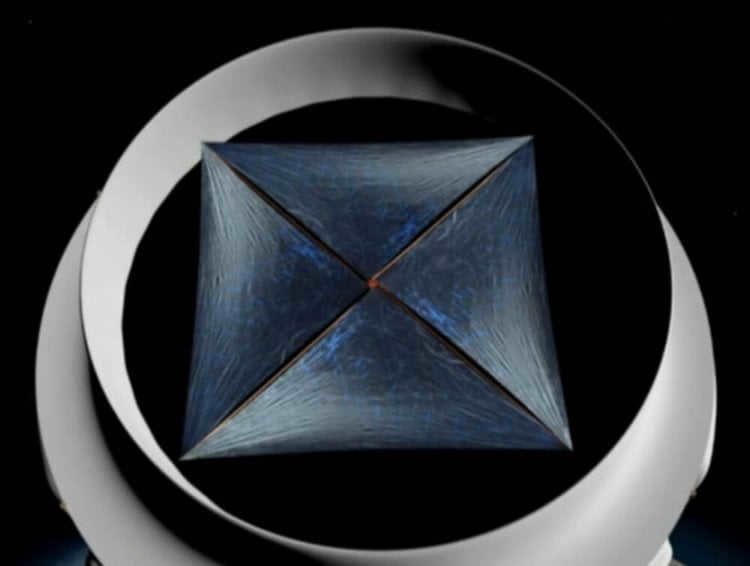
A depiction of the suggested light sail technology
Nevertheless, there are alternative proposals to achieve this endeavor. As per Heller and Hippke, employing a larger “photon” sail would eliminate the requirement for a laser array. Simultaneously, the probe itself would be minuscule, measuring a few centimeters in size and weighing only a few grams. To facilitate acceleration and departure into interstellar space, the device would incorporate multiple sizable sails that are remarkably lightweight, thin, and robust. According to the plan presented by European scientists for the trajectory towards Alpha Centauri, the probe would be propelled by the radiation emitted by our Sun. Once it attains the necessary level of inertia, the device would retract the sails and continue its voyage towards the neighboring star system.
Scientists hypothesize that in this scenario, the spacecraft will have the potential to achieve 4.6 percent of the speed of light and will arrive at Alpha Centauri in approximately 95 years. Although this duration is nearly five times longer than the original Milner and Hawking proposal, it would theoretically streamline the challenge of decelerating the spacecraft at the desired destination.
"The inclusion of any type of propellant would only complicate the overall mission. If the spacecraft were to carry fuel onboard, it would add unnecessary weight, thereby increasing the demand for an even larger fuel supply."
Ion engine
The possibility of using ion engines for spaceflight has been explored by rocket designers. This technology has been mentioned in works of science fiction dating back to the 1950s and has also been implemented in practical applications.
The first spacecraft to utilize an ion engine as its primary propulsion system was Deep Space-1. Instead of the typical fiery exhaust produced by conventional rockets, the ion engine emits a mysterious blue glow. This glow is the result of electrically charged xenon atoms being expelled from the engine. Xenon, the same gas used in light bulbs, is used in this process to generate thrust. The ions are propelled into space at speeds of approximately 110,000 kilometers per hour. However, due to its greater weight, Deep Space-1 did not travel at this velocity.
However, if you are not in a rush, this technology will be suitable for you. Calculations and experiments indicate that in a single day, this thruster can increase the spacecraft’s velocity by 25-32 kilometers per hour. Throughout the Deep Space-1 mission, the ion engine boosted its speed by an impressive 11,000 kilometers per hour.
By employing this technology, it would take approximately 4,900 years to achieve half the speed of light. For a voyage to Alpha Centauri, the spacecraft would accelerate for half of the journey and then decelerate for the remaining half.
With ion propulsion technology, we could potentially reach Mars in just 270 days!
What is the distance to the nearest star?
The universe is incredibly vast. Even the stars that are closest to us are situated at a great distance. However, if we were to embark on a journey to the nearest star, how long would it take? Let’s crunch the numbers.
With the current technology at our disposal, and by utilizing a “gravity slingshot” method involving Jupiter, it is estimated that we could potentially attain speeds of approximately 350,000 kilometers per hour. The Parker Solar spacecraft, for instance, has achieved speeds of 343,000 kilometers per hour, setting the record for the fastest speed ever reached by a man-made object.
Alpha Centauri is positioned approximately 4.3 light years away from our planet Earth, which equates to a staggering 40 trillion kilometers. If we were to travel at this velocity, it would require an estimated duration of 15,000 years to successfully arrive at this mesmerizing triple star system. However, it is worth contemplating whether alternative methods of interstellar transportation exist. Is the field of science stagnant? The answer is a resounding no. In actuality, the realm of scientific discovery is in a constant state of contemplation and innovation.
A Comprehensive Guide to the Costly Expedition to Alpha Centauri (No, it’s not a Prank)
An affluent individual from Silicon Valley has expressed his desire to journey to the closest star. Equipped with a substantial amount of money and the support of his associates – including renowned physicist Stephen Hawking – entrepreneur Yuri Milner has devised a venture known as Breakthrough Starshot. Since the revelation of this enigmatic undertaking, you may have found yourself pondering numerous questions. Let us attempt to provide some clarity.

In brief, what is the objective of the project?
Hang on… What is a laser sail?
The distances between stars are so vast that for typical interstellar travel (which won’t take millions of years), it will be necessary to accelerate the spacecraft to a significant fraction of the speed of light. Instead of propelling through space using the gentle push of the Sun’s photons like solar sails, Starshot’s laser sail will be propelled by a 100 billion watt laser array. On Earth, such a laser could accelerate a spacecraft weighing as little as a feather to 20% of the speed of light.
That’s quite rapid, but even at that velocity, it would require 20 years to reach the Alpha Centauri system. The spacecraft would swiftly pass by, capture a few photons, and transmit them back to Earth.
What if the fast-moving nano-device collides with an object along the way?
There are numerous potential dangers that a spacecraft traveling at a fraction of the speed of light could face if it were to collide with even the tiniest speck of dust. In fact, the only possible outcome would be complete annihilation. However, considering that space is incredibly vast and void of matter, the team of engineers working on this project believes that the chances of a collision are quite low.
Great! When can we expect to see photos of Alpha Centauri on Instagram?
At this moment, it is unclear when exactly the photos of Alpha Centauri will be uploaded to Instagram. The launch itself may occur within the next few decades. However, for now, the project needs to be carefully planned and put on paper. It is a high-stakes venture, costing $100 million, as Starshot cannot proceed without securing additional resources. Furthermore, the launch of something like StarChip would require billions of dollars.
Why dedicate such a significant amount of resources just to visit Alpha Centauri?
The Alpha Centauri system marks the initial stage of an extraordinary interstellar odyssey. In terms of the cosmos, this stellar system is essentially within our cosmic neighborhood, a mere distance of 4.37 light-years, which equates to trillions of kilometers.
Alpha Centauri consists of a trio of stars, offering a wealth of celestial wonders to behold. Among these stars, the nearest to Earth is the faint red star known as Proxima Centauri, situated 4.24 light-years away. The other two stars closely resemble our own Sun and possess greater scientific intrigue. These stars revolve around each other in a synchronized dance, completing an orbit every 80 years.
Do any planets exist within the vicinity of the stars in the Alpha Centauri system?
It is possible that there is a potentially solid planet near Alpha Centauri B, the younger of the system’s two sun-like stars, as scientists announced in 2012. However, despite efforts to find evidence of this planet, repeated observations have been unsuccessful in detecting any gravitational tugs that would indicate its presence.
Is it possible to view Alpha Centauri?
If you are located in the southern hemisphere, you can see Alpha Centauri. To the naked eye, this system appears as a distinct bright blue star next to the Southern Cross. It is the third brightest star in the sky and is part of the Centauri constellation. In the northern hemisphere, Alpha Centauri is more difficult to spot as it does not rise high enough above the horizon. However, with knowledge of its location and the appropriate timing, it is still possible to observe.
How will the nanocamera capture images of Alpha Centauri?
The Starshot team is currently working on the project. Initially, the images are expected to be a single continuous line, as the Starship will be traveling at incredibly high speeds, covering the distance from Earth to the Sun in just one night. The engineers are working on developing optics that can capture images at such speeds, but if they are unsuccessful, the resulting images may appear blurry. Additionally, it will take a considerable amount of time for the images to reach Earth, as nothing can travel faster than the speed of light. In fact, it will take over four years for the images to make their way back to us.
Is it possible to simplify the process by placing the laser array in space?
Originally, that was the plan. The idea was conceived by Robert Forward many years ago. Forward’s early research focused on using space-based laser arrays to accelerate spacecraft, as the Earth’s atmosphere absorbs light and reduces the effectiveness of a ground-based array.
Is there a possibility that the new technology will be useful in a closer location?
Stars, hold on for us
However, there are obstacles preventing these advancements. Ion engines are highly intricate in their design and a significant amount of propellant would be necessary for any substantial expedition.
But we should not lose hope. There are still projects involving rocket engines powered by nuclear energy. Theoretical calculations suggest that the speed of the propellant in nuclear engines could reach 20% of the speed of light or even higher. With such velocities, a journey to Alpha Centauri could be completed in less than 25 years!
And this time frame is practically insignificant in the grand scheme of the Universe.
Friends! If you enjoyed this article, please like and subscribe to our channel! Thank you!
How to Travel to Outer Space
A duo of European researchers may have discovered the ultimate solution to this inquiry. In a scholarly article featured in The Astrophysical Journal Letters, physicist René Heller from the esteemed Max Planck Institute and computer scientist Michael Hippke detail a novel method for utilizing the radiation and gravitational forces emanating from stars within the Alpha Centauri system to decelerate a spacecraft. Instead of merely passing by, the spacecraft, equipped with a cutting-edge light sail, would have the ability to reduce its speed significantly, allowing for an extensive investigation of the intricate workings of the triple star system and, quite possibly, even the examination of Proxima b, a potentially habitable exoplanet situated near one of its stars.
Recall that within the Breakthrough Starshot Initiative, Milner intends to invest $100 million in the advancement of an ultra-lightweight, self-governing spacecraft equipped with a light sail, capable of achieving speeds of 1/5 the speed of light (approximately 60,000 km/s). This groundbreaking technology will empower the robotic probe to reach Alpha Centauri – the nearest stellar system to Earth – in a mere 20 years, as opposed to the traditional chemical propulsion methods which would require 100,000 years.
Can we travel to Alpha Centauri?
In 2016, renowned theoretical physicist Stephen Hawking and Russian billionaire Yuri Milner unveiled an audacious project to send a miniature spacecraft to the Alpha Centauri system. Naturally, this bold endeavor necessitates the discovery of equally audacious solutions. For instance, a lingering quandary is how a spacecraft, hurtling through space at 20% of the speed of light, could come to a halt upon arrival. Is such a maneuver even feasible?
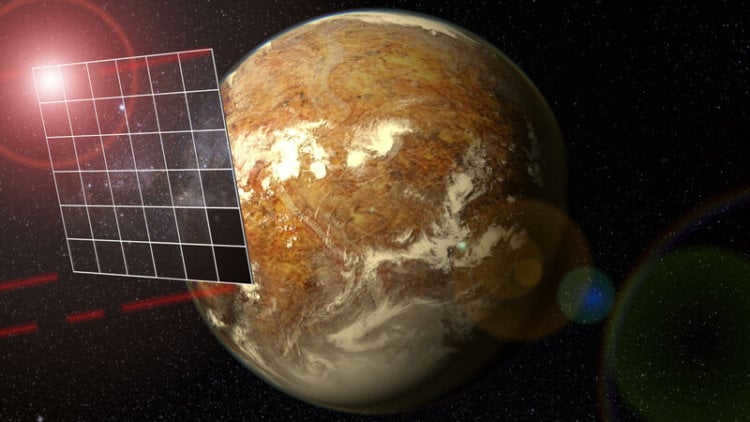
Space exploration is far more complex than it appears.
The Importance of Deep Space Travel
However, the additional time spent, as per experts, will yield considerable benefits. One of the most remarkable discoveries of 2016 was the detection of an exoplanet resembling Earth near the Proxima Centauri star. Ultimately, the ability to examine this planet from close proximity could potentially be one of the most significant events in modern astronomy. Transmitting the accumulated data about the planet back to Earth would require a little over 4 years, taking into account the distance. Unfortunately, this remains merely a vision for the time being, as we currently lack systems that are both compact enough to be fitted onto a nanoscale probe and possess the necessary power to transmit signals over such vast distances.
Before sending a probe to a neighboring star system, there are several challenges that need to be addressed, and the lack of a suitable transmitter is just one of them. It is equally important to find a solution and develop a power system that is suitable for the probe. However, researchers remain optimistic, as science is constantly evolving. It is exciting to note that laboratories have already made significant progress in developing ultralight materials that will be essential for this project.
Furthermore, the scientist suggests that the surface of the sail should be designed to reflect waves from the blue and red portions of the visible spectrum, and possibly even beyond.
“Although we do not currently possess such advanced technology, scientific laboratories have made significant advancements in recent years. Researchers have identified materials capable of reflecting nearly 99.9 percent of light volume.”
Heller and Hippke plan to present their comprehensive proposal to the steering group of the Breakthrough Starshot Initiative at the forthcoming Breakthrough Discuss conference, scheduled to take place in Palo Alto, USA, this April.
How to Decelerate in a Timely Manner
Considering these constraints and the current lack of a suitable solution, scientists hypothesize that in this scenario, the probe will merely pass by Alpha Centauri, similar to how the spacecraft “New Horizons” flew past Pluto. However, due to the disparity in velocities, the probe, unlike New Horizons, will be unable to provide any reasonably precise measurements of this star system. Fortunately, according to the two scientists, there exists a potential option that, in theory, would not only allow for the spacecraft to decelerate to acceptable speeds at the appropriate moment but also enable a comprehensive examination of the Alpha Centauri system.
“We have discovered a technique that enables us to decelerate the spacecraft by harnessing the energy of the star itself. Photons can be utilized to reduce the speed of the light sail. Consequently, there will be no need for extra fuel onboard. This strategy aligns perfectly with the overarching vision set forth by the Breakthrough Starshot Initiative.”
During the deceleration maneuver, the probe will have to come close to Alpha Centauri A at a distance equal to five times its own radius, or approximately 4 million kilometers, in order to be captured in its orbit. Starting from that moment, the spacecraft will start decelerating to about 2.5 percent of the speed of light. However, it should be emphasized that in case the deceleration fails from its maximum speed (4.6 percent of the speed of light), the probe will be expelled back into interstellar space.
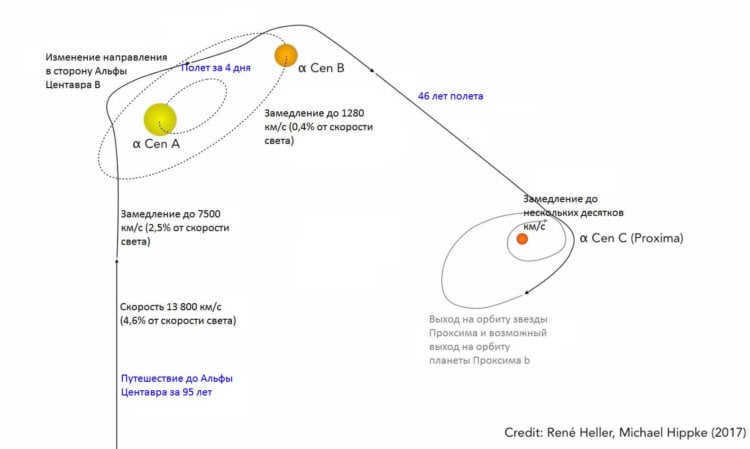
The commencement of every prosperous expedition commences with the fabrication of a chart. This situation exemplifies all the maneuvers executed by the self-governing space nanoapparatus on its expedition towards Alpha Centauri A, from which the expedition to Alpha Centauri B will only require four days. The ultimate assignment of the probe could potentially be a 46-year expedition towards the star Proxima Centauri, the residential location of the earth-like planet Proxima b





